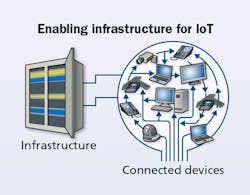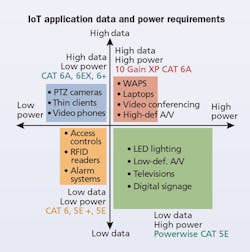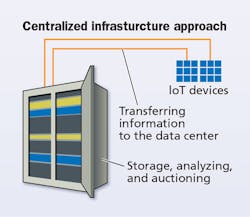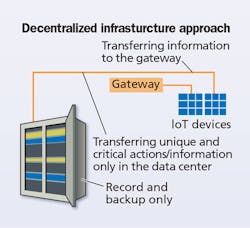By Jason Finnegan and Justin Baillargeon, Legrand
The world around us is changing rapidly as technology becomes increasingly intertwined with our day-to-day routines. With advancements in technology, not only have we become smarter thanks to the wealth of information at our fingertips, but so have the devices we rely on. Smarter devices are enabling a new type of infrastructure-an intelligent network built on the Internet of Things (IoT).
Simply defined, the Internet of Things is a network of uniquely identifiable endpoints (or “things”) that contain embedded technology to sense, collect and act on data locally or with external environments, without human interaction. IoT is making an unprecedented impact on how commercial buildings are managed and operated. In a building network environment, IoT enables workers responsible for various operations to be more effective and efficient through better delegation, faster responses and improved quality and control. In fact, according to Gartner, IoT can help reduce the cost of energy, spatial management and building maintenance by up to 30 percent. With an IoT-ready building design, the cost of system integration is greatly diminished, new hardware requirements are minimal and leading-edge apps or web-based software are becoming the norm. We are getting closer to the holy grail of facility management with more functional and efficient buildings.
Helping empower this change in building design is the use of the Internet Protocol (IP) as the communication protocol of these new devices. IP convergence will be especially important within the next-generation commercial building, an ecosystem of ubiquitous heterogeneous devices, people and systems, which interact in real time. As we migrate toward an inevitable fully IoT-enabled building, we will see the convergence of power, light and data over a common cabling system for a variety of applications.
Connected devices and enabling infrastructure
When we start to look at this new building environment we will need to take a closer look at two terms to better understand the design impact the Internet of Things will have.
“Connected devices” can refer to a wide variety of “things” such as smart thermostats, telephones, security cameras, access control systems and more. These devices support various applications by collecting useful data with the help of various existing technologies and then autonomously communicating the data between other devices to make enhancements to the surrounding environment without human interaction. Connected devices often leverage the IP and many are already able to be powered and networked using a single cable with existing Power over Ethernet (PoE) technologies.
“Enabling infrastructure” refers to the structure beyond the “things” that make the IoT philosophy possible. It includes the platforms that facilitate a common language for all devices to communicate freely, the “collect and act” scenarios that are the essence of the IoT movement and the “enablers,” such as PoE, wireless access points, gateways and edge devices. The cabling infrastructure that makes up the “physical” deployment of the IoT installment is at the core of these systems. A structured cabling infrastructure provides the required foundation to support these applications.
Convergence of power, light and data
Data: Enabling an IoT infrastructure with Ethernet - With devices and applications leveraging IP for communication and Ethernet providing a standard method for delivery, we are seeing the convergence of connected devices over Ethernet. This allows for IoT networks to be designed and managed alongside existing and evolving industry standards, including TIA and IEEE, to ensure safe and consistent operation of devices on a common infrastructure.
PoE: Ethernet cabling system a viable power path - Applications converging over IP allow communications to occur over Ethernet, a common standard that has evolved to support both data and low-voltage power over industry-standard category cabling. Many of the applications mentioned previously are also leveraging devices, or “things” that have become more power-efficient. With these devices having lower power requirements, they are now able to be powered using low-voltage direct current (DC) over a single twisted-pair cable. The IEEE sets the standard for Power over Ethernet (PoE), which allows for the simultaneous transmission of data and low-voltage power over twisted-pair cabling. There are also other solutions in the market that support transmission of power and data, including Cisco’s UPOE (Universal Power Over Ethernet) solution and the AV industry’s Power over HDBase-T (PoH).
Current IEEE standards allow for devices under 30 watts to be powered and networked using a single category cable. This power and data delivery allows for the convergence onto traditional structured cabling infrastructures that are already being used in many commercial buildings today. Voice over Internet Protocol (VoIP) phones found in most offices today are already being powered using this method, in which a single cable is providing both voice (data) and power. With the upcoming ratification of 4-pair PoE, 802.3bt, the latest IEEE standard will allow up to 100 watts of DC power to be delivered from the power source equipment alongside data transmissions in a single category cable.
Increased power, increased heat
With the upcoming IEEE 802.3bt standard for 4-pair PoE, the increase to 100-watt power delivery through twisted-pair cabling will place additional requirements on the cabling and infrastructure used to support IoT applications.
With an increased power load, heat dissipation must happen efficiently to ensure proper performance of the cable. The ambient temperature of the pathway, as well as cabling temperature ratings, must be taken into account.
The Telecommunications Industry Association (TIA) recommends that a single cable delivering power and data not exceed an increase of 15 degrees Celsius temperature from the ambient temperature around the cable. The number of cables bundled together has a direct impact on the temperature rise. When evaluating your category cable, ensure it can provide enough temperature headroom in most cable bundle sizes to not exceed the 15-degree Celsius limit when 100 watts of power is being delivered.
When deploying IoT applications that use twisted-pair cable, it’s important to take into consideration the mix of power and data that a device requires. Applications like LED lighting require higher power, but low data bandwidth. In contrast, applications like multi-band and multi-antenna wireless access points require high bandwidth and high power throughput.
Centralized and decentralized designs
When deploying connected devices that leverage the structured cabling infrastructure for communication and power, two deployment models-centralized and decentralized-should be considered to ensure proper performance and reliability of the overall system. A centralized approach uses a central location where analysis, storage and computing take place. IoT devices are individually connected back to the centralized location, most often through a telecom room, although a cloud service or remote data center can also be used. With the number of connected devices growing on a rapid scale, the central location will need to grow as well. Additional racks may need to be deployed to support these growing number of connections, with the opportunity to segregate out racks dedicated to different IoT applications and functions.
The majority of networked applications today use this approach and it is considered the proper deployment method for wireless access points. Some emerging LED lighting systems are also using this method in deploying their PoE-powered lighting nodes. Centralizing data center functions in a single location allows for easier management of the active equipment, but may make it difficult to run new services and devices after the initial deployment has finished.
A decentralized approach, sometimes referred to as a zone approach, employs the use of distributed equipment, often located in ceiling or wall enclosures, throughout the building to analyze, store and process data from nearby IoT devices. This contributes to decisions being made at a much more efficient rate with less distance to travel, as well as distributing workloads. Each zone may have one or more enclosures that house the networking, processing, storage and power components of that zone with only a single or few connections being sent back to the floor’s telecom room. This reduces the number of long cable runs and makes it more efficient to add or remove devices from zones.
The distribution of the active equipment lends to shorter cable runs for applications that require greater power delivery and efficiency. The shorter the cable run, the more power that cable is able to provide to the end device. Intelligent LED lighting applications, security cameras and more can benefit from this model.
A hybrid approach uses both deployment models and is a more likely scenario. For example, wireless access points run on a centralized model and applications with more connected devices, like PoE lighting, benefit from a decentralized approach.
Many disparate services and applications operate in the commercial office and building network today. With advancements in technology and evolving standards we are witnessing a change in the supporting network infrastructure of the building. A future where we witness the convergence of lighting, security, HVAC, telephony, occupancy and more applications over a single cabling infrastructure is not that far off. New demands are going to be placed on the infrastructure and it is important to understand those demands and plan accordingly.
Jason Finnegan is in product marketing and Justin Baillargeon is in advanced marketing with Legrand (www.legrand.us).




